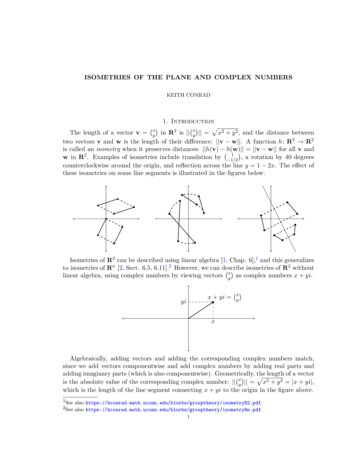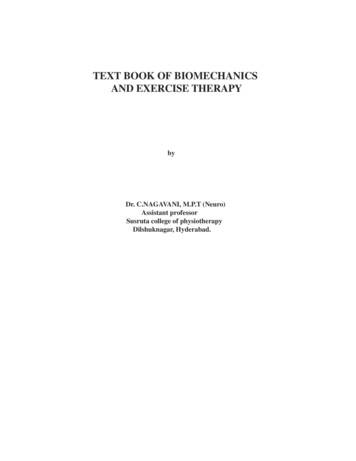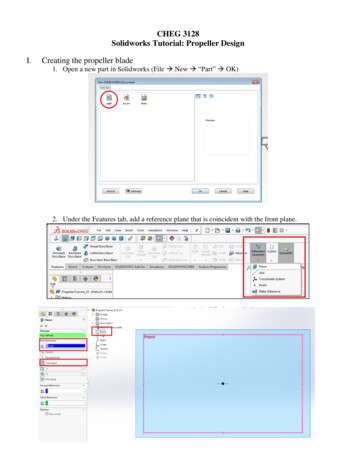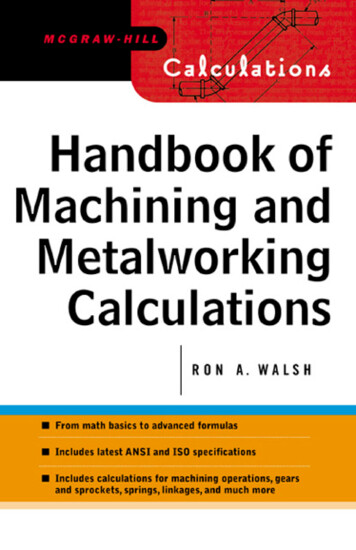
Transcription
ISOMETRIES OF THE PLANE AND COMPLEX NUMBERSKEITH CONRAD1. Introductionp The length of a vector v y in R2 is xy x2 y 2 , and the distance betweentwo vectors v and w is the length of their difference: v w . A function h : R2 R2is called an isometry when it preserves distances: h(v) h(w) v w for all v and12w in R . Examples of isometries include translation by 1/2 , a rotation by 40 degreescounterclockwise around the origin, and reflection across the line y 1 2x. The effect ofthese isometries on some line segments is illustrated in the figures below. xIsometries of R2 can be described using linear algebra [1, Chap. 6],1 and this generalizesto isometries of Rn [2, Sect. 6.5, 6.11].2 However, we can describeisometries of R2 without xlinear algebra, using complex numbers by viewing vectors y as complex numbers x yi.yix yi xy xAlgebraically, adding vectors and adding the corresponding complex numbers match,since we add vectors componentwise and add complex numbers by adding real parts andadding imaginary parts (which is also componentwise). Geometrically,the length of a vectorp is the absolute value of the corresponding complex number: xy x2 y 2 x yi ,which is the length of the line segment connecting x yi to the origin in the figure above.1See also isometryR2.pdf.2See also isometryRn.pdf.1
2KEITH CONRADThe distance between two complex numbers z and w is z w , so if the vectors v and win R2 correspond to the complex numbers z and w, then v w z w . Therefore ifwe think of R2 as C, an isometry of R2 can be viewed as a function h : C C satisfying h(z) h(w) z w for all z and w in C. Our goal is to describe all the isometries of theplane using algebraic operations with complex numbers. The reason that we will be able todo this is based on four features of complex numbers.(1) Addition by x yi is the translation of the plane by the vector (x, y).(2) Multiplication by cos θ i sin θ, a complex number of absolute value 1, is a counterclockwise rotation around the origin by an angle of θ. In particular, for nonzeroγ C the pair {γ, iγ} is an orthogonal basis of C as a real vector space.(3) Complex conjugation has the effect of reflection across the x-axis, so in particularsolutions to z z lie on a line (in fact the real line).(4) The absolute value on C, which is connected to the distance formula via z w ,behaves nicely with respect to multiplication in C and complex conjugation: zw z w and z z .(1.1)In Section 2, we will algebraically derive formulas for all isometries of the plane usingcomplex numbers. These formulas will be interpreted geometrically in Section 3.2. Algebraic argumentsFor all z C, consider the two types of functions C C:(2.1)h1 (z) αz β,h2 (z) αz β,where α 1 and β is a complex number. These formulas are both isometries. Indeed,h1 (z) h1 (w) α(z w),h2 (z) h2 (w) α(z w).By (1.1), h1 (z) h1 (w) z w and h2 (z) h2 (w) z w for all z and w in C.We will show every isometry of the plane is given by one of the formulas in (2.1).Lemma 2.1. An isometry of the plane that fixes 0, 1, and i is the identity.Proof. Let h be such an isometry. Since h(0) 0, h(1) 1, and h(i) i, for each z Cthe formula h(z) h(w) z w at w 0, 1, and i becomes(2.2) h(z) z , h(z) 1 z 1 , h(z) i z i .This says h(z) and z have the same distances from the three numbers 0, 1, and i. Geometrically, it is plausible that a complex number is completely determined by its distancesfrom 0, 1, and i: three circles centered at each of these points can’t intersect in more thanone common point. Granting this, we conclude from (2.2) that h(z) z.To check this algebraically, we want to show for w and z in C that(2.3) w z , w 1 z 1 , w i z i w z.Square the three equations in (2.3) and use the formula u 2 uu for u C:ww zz, (w 1)(w 1) (z 1)(z 1), (w i)(w i) (z i)(z i).Expanding the second and third equations, and feeding in the first, we obtain after simplifyingw w z z, w w z z.Therefore w and z have equal real parts and equal imaginary parts, so w z.
ISOMETRIES OF THE PLANE AND COMPLEX NUMBERS3Theorem 2.2. Each isometry of the plane is given by one of the formulas h1 (z) αz βor h2 (z) αz β for unique α and β in C where α 1.Proof. In both formulas, β hi (0) and α hi (1) hi (0) for i 1, 2. This suggests that,for an unknown isometry h : C C, we defineβ h(0),α h(1) h(0).Then α h(1) h(0) 1 0 1. Now consider the functionh(z) βh(z) h(0) .αh(1) h(0)We expect this function is either z or z.Note first of all that k(z) is an isometry:(2.4)k(z) : k(z) k(w) (h(z) β) (h(w) β) h(z) h(w) z w .αWith Lemma 2.1 in mind, we compute k(z) at z 0, 1, and i. Easily k(0) 0 and k(1) 1.What about k(i)?Since k fixes 0 and 1, k(i) k(i) k(0) i 0 1, k(i) 1 k(i) k(1) i 1 2, so k(i) lies on both the unit circle and the circle around 1 of radius 2. There are only twosuch points: i and i.i01 iIf k(i) i, then k is an isometry fixing 0, 1, and i, so k(z) z for all z by Lemma 2.1.If k(i) i, then k(z) is an isometry fixing 0, 1, and i, so Lemma 2.1 tells us k(z) z forall z. Conjugating, k(z) z for all z.Since h(z) αk(z) β, the two possible formulas for k(z) lead to the desired possibleformulas for h(z). The uniqueness of α and β is clear from α h(0) and β h(1) h(0). Corollary 2.3. Every isometry of the plane is an invertible function and its inverse functionis an isometry.Proof. If h(z) αz β with α 1, its inverse is (1/α)z β/α with 1/α 1. Ifh(z) αz β with α 1, its inverse is (1/α)z β/α with 1/α 1. Both inverses havethe shape of the formulas in Theorem 2.2 (e.g., the coefficient of z or z has absolute value1), so these inverse functions are isometries. The composition of two isometries is an isometry, and composition of functions is associative, so Corollary 2.3 shows the isometries of R2 are a group under composition.Now we can generalize Lemma 2.1.
4KEITH CONRADLemma 2.4. If an isometry of the plane fixes three points that are not collinear, then thatisometry is the identity.We need to assume in the lemma that the isometry has at least three fixed points thatare not collinear, since an isometry fixing three collinear points need not be the identity:it could be a reflection across the line through the two points. (Two different points arealways fixed by some non-identity isometry: the reflection across the line through them.)Proof. We can write an isometry h(z) as αz β or αz β, where α 1. Unless h(z) isthe identity, we will show h(z) can’t have 3 fixed points that don’t lie on a line.Case 1: h(z) αz β. If α 6 1 then there is only one solution to h(z) z, namelyz β/(1 α). If α 1, so h(z) z β, then there are no solutions to h(z) z if β 6 0.So unless α 1 and β 0, which means h is the identity, h(z) has at most 1 fixed point.Case 2: h(z) αz β. The condition h(z) z is the same as αz β z. We will showthe set of solutions to this equation, if it is not empty, lie along a line. Thus h doesn’t havethree fixed points not lying on a line. Let w and z both be fixed points of h, so αz β zand αw β w Subtracting one equation from the other,(2.5)α(w z) w z.If α were 1, then w z w z, so t : w z is real and w z t. This means all fixedpoints of h are on the horizontal line through z, so three fixed points of h can’t be collinear.What if α 6 1? Here there is a clever trick with square roots. All complex numbers aresquares, so we can write α γ 2 . Then γ 1, so γ 1/γ, which means α γ/γ and (2.5)becomes w zw z .γγThus t : (w z)/γ is real, so w z tγ. Now w lies on the line with direction γ passingthrough z, so again all fixed points of h lie on a line. Theorem 2.5. An isometry of the plane is determined by its values at three noncollinearpoints: if two isometries h1 and h2 are equal at three noncollinear points, then h1 h2everywhere on the plane.Proof. The isometry h2 is invertible and its inverse is an isometry, by Corollary 2.3. Tosay h1 (z) h2 (z) is the same as saying (h 12 h1 )(z) z. Therefore our hypothesis says thecomposite function h 1h,whichisanisometry(we mentioned earlier that the composition12of isometries is an isometry) fixes three noncollinear points, so by Lemma 2.4 it is theidentity: (h 1 2 h1 )(z) z for all z C, so h1 (z) h2 (z) for all z.3. Geometric argumentsNow we want to understand the geometry behind the formulas in (2.1). We will see thatthe isometries of the plane fall into four types: translations, rotations, reflections, and glidereflections. A glide reflection is the composition of a reflection and a nonzero translation ina direction parallel to the line of reflection. A picture of a glide reflection is in the figurebelow, where the line of reflection is dashed and the translation is a movement to the right.
ISOMETRIES OF THE PLANE AND COMPLEX NUMBERS5The image above, which includes “before” and “after” states, suggests a physical interpretation of a glide reflection: it is the result of turning the plane in space like a half-turnof a screw. A more picturesque image, suggested to me by Michiel Vermeulen, is the effectof successive steps with a left foot and then a right foot in the sand or snow (if your feetare mirror reflections).We will look at the functions in (2.1) and see how they are one of the four types ofisometries in terms of conditions on the parameters α and β in each case. Table 1 summarizesthe relations we will prove between the geometric description of an isometry and the formulafor the isometry. In the table, α 1 and γ 2 α. (The only isometry belonging to morethan one of the four types is the identity, which is both a translation and a rotation, so wemake the identity its own row in the table.)FormulaFixed pointsIsometryIdentityzCNonzero Translationz β, with β 6 0 Nonzero Rotationαz β, with α 6 1β/(1 α)αz β, with β 2 /α ( , 0]β/2 RγReflectionGlide Reflectionαz β, with β 2 /α 6 ( , 0] Table 1. Isometries of R2In this table, the only nonidentity isometries fixing more than one point are reflections,whose fixed points lie along a line. This is a better way of understanding Lemma 2.4.Now we turn to the justification of the information in Table 1.Case 1: h(z) z β. This is a translation of the plane by β. It has no fixed pointsunless β 0, in which case h is the identity and all points are fixed.Case 2: h(z) αz β, α 6 1.The unique fixed point of h is z0 β/(1 α). We expect h should be a rotation aroundz0 . To prove this, express h(z) in terms of its fixed point z0 :(3.1)h(z) αz β αz (1 α)z0 α(z z0 ) z0 .Since multiplication by α (of absolute value 1, and not equal to 1) is a nontrivial rotationaround 0, (3.1) tells us h is a rotation around z0 : the process of subtracting z0 , multiplying by α, and then adding back z0 amounts to rotating around z0 by the nonzero angledetermined by α as a rotation around 0.Case 3: h(z) αz β. There may be some fixed points or there may be no fixed points.For instance, the equation z z has the real line as its fixed points, while the equationz 1 z has no fixed points. It will turn out that h has either a whole line of fixed points
6KEITH CONRAD(in which case we will show h is the reflection across that line) or it has no fixed points (inwhich case we will show h is a glide reflection).In the proof of Lemma 2.4 we studied the equation αz β z using a square root of α.Let’s bring back that square root. Write α γ 2 , so γ 1 (since α 1). From the proofof Lemma 2.4, if w and z are both fixed points of h then w zw z ,γγso t : (w z)/γ is real and w z tγ. Conversely, for real number t and complex numberz such that αz β z, check that the number w z tγ satisfies αw β w. Thereforethe set of fixed points of h(z) αz β is(3.2){z0 tγ : t R} z0 Rγ,where z0 is a fixed point.The function αz β may not have fixed points (e.g., h(z) z 1). A necessary andsufficient condition on α and β in order for the isometry h(z) αz β to have a fixedpoint is that β 2 /α ( , 0]. To see why this is necessary, suppose αz β z for some z.Applying complex conjugation to this equation gives us αz β z, so we must havez β αz β.αSince α 1/α, the terms z/α and αz in the second equation above match, and subtractingthem leaves us with β/α β, so β 2 /α ββ β 2 ( , 0]. Conversely, ifβ 2 /α ( , 0], write β 2 /α c2 where c 0. Taking absolute values implies β 2 c2and (miracle!) the number β/2 is a fixed point of h: βββ2ββ β 2ββh α· β 2 β 2 β β .222c2c22z To summarize, h(z) αz β has a fixed point if and only if β 2 /α ( , 0], in which caseβ/2 is a fixed point, so (3.2) tells us that the set of all fixed points of h is the lineβ Rγ,2where γ 2 α. See the figure below. We will prove h is reflection across the line β/2 Rγby checking two properties: for all z, the average 21 (z h(z)) lies on the line β/2 Rγ, for all z, the difference z h(z) is perpendicular to the line β/2 Rγ.iγβ/2 Rγαγβ/2βzαzzh(z)
ISOMETRIES OF THE PLANE AND COMPLEX NUMBERS7For the first property,z αz β2β z γ2z 22β γz γz γ.22The number γz γz γz γz is real, so this average is on the line β/2 Rγ. For thesecond property,z h(z)2 z h(z) z (αz β) γγz γ 2 z β (γz γz)γ β.We want this to be orthogonal to the direction of γ (which is the direction of the lineβ/2 Rγ). Multiplication of a complex number by i rotates it 90 degrees counterclockwise,so the direction orthogonal to γ is the direction of iγ. The difference γz γz γz γz ispurely imaginary, so the first term in the formula for z h(z) is in Riγ. What about β?Since β 2 /α ( , 0], write β 2 αc2 for real c. Then β 2 γ 2 c2 , so β icγ Riγ.Thus z h(z) Riγ. That completes the proof that h is the reflection across the lineβ/2 Rγ.The remaining type of isometry is h(z) αz β with no fixed points, so β 2 /α 6 ( , 0].Before we show h is a glide reflection (that is, a composition of a reflection and a nonzerotranslation in a direction parallel to the line of reflection), let’s look at two examples.Example 3.1. Let h(z) z 1. This is a reflection across the x-axis composed with atranslation (by 1) in a direction parallel to the line of reflection.Example 3.2. Let h(z) z (1 i) (z i) 1. Since i w w for w i/2, thefunction z 7 z i is a reflection across the horizontal line i/2 R. Thus h is a compositionof a reflection across a line and a translation (by 1) in a direction parallel to that line.To see that h(z) αz β describes a glide reflection when it has no fixed points, writeα γ 2 . Using {γ, iγ} as an R-basis of C, we can write β aγ biγ with real a and b.Then(3.3)h(z) αz β αz (aγ biγ) (αz biγ) aγ.(biγ)2 /αSince b2 0, our earlier discussion of reflections tells us that αz biγ is areflection across a line parallel to Rγ. Since β 2 /α 6 ( , 0], we must have a 6 0. Thereforeadding aγ in (3.3) amounts to composition of a reflection across a line parallel to Rγ witha nonzero translation in a direction parallel to the same line. Hence h is a glide reflection.This completes the justification of Table 1, although we should also emphasize why thedifferent types of isometries in Table 1 are different from each other. Looking at the set offixed points (empty, point, line, plane) easily distinguishes the first four types of isometriesfrom each other and distinguishes a glide reflection from all but a translation. To show aglide reflection is not a translation, if h(z) αz β were a translation then h(z) z wouldbe constant, but h(z) z αz z β is not constant: from h(0) 0 h(1) 1 h(i) ithe first equation would imply α 1 and the second would imply α i.We now draw a few conclusions about plane isometries from the formulas in Table 1.
8KEITH CONRADTheorem 3.3. The composition of two reflections is a translation or a rotation, and it isa translation precisely when the two reflections are across a pair of parallel lines.Proof. Let s1 and s2 be two reflections, so s1 (z) α1 z β1 and s2 (z) α2 z β2 , whereα1 and α2 have absolute value 1 and β12 /α1 and β22 /α2 are in ( , 0]. Thens1 (s2 (z)) α1 (α2 z β2 ) β1 (α1 α2 )z (α1 β 2 β1 ).This has the form αz β where α α1 α2 , so α 1. Table 1 tells us that s1 s2 is atranslation or rotation (possibly the identity).The composite s1 s2 is a translation precisely when α1 α2 1, which (since α2 1/α2 )amounts to saying α2 α1 . Then s1 (z) α1 z β1 and s2 (z) α1 z β2 . The fixedlines of these reflections are β1 /2 Rγ and β2 /2 Rγ, where γ 2 α1 , so these lines areparallel. Example 3.4. Let s1 (z) z 3, s2 (z) z 5, and s3 (z) z i. Their respective linesof reflection are 3/2 Ri (horizontal), 5/2 Ri (horizontal), and i/2 R (vertical). Thecomposite s1 (s2 (z)) is z 2, which is a translation. The composite s1 (s3 (z)) is z (3 i),which is a rotation around (3 i)/2 by 180 degrees.Theorem 3.5. If g and h are two isometries of the plane, ghg 1 is an isometry of thesame type as h.Proof. Write g(z) αz β. For a translation t(z) z c, an explicit calculation shows(gtg 1 )(z) z αc. If we have z in place of z in g(z), then (gtg 1 )(z) z αc. Thusgtg 1 is a translation for every isometry g.For two plane isometries g and h, h fixes z if and only if ghg 1 fixes g(z). An isometrytakes a point or a line to a point or a line, respectively, so from our knowledge of fixedpoints of different kinds of isometries we see that if h is a rotation then ghg 1 is a rotation(1 fixed point), and if h is a reflection then ghg 1 is a reflection (a line of fixed points).(We can say something more precise in the case h(z) αz β is a rotation. When g is atranslation or rotation (ghg 1 )(z) αz , while when g is a reflection or glide reflection(ghg 1 )(z) αz . Therefore ghg 1 is a rotation by the same angle as h or the oppositeangle to h, at some point in the plane.)Suppose h is a glide reflection, so it has no fixed points. Then ghg 1 also has no fixedpoints, which means ghg 1 is either a glide reflection or a translation. If ghg 1 were atranslation, say ghg 1 t, then h g 1 tg, which is a translation by the first paragraph(replace g with g 1 there). That is a contradiction, so ghg 1 must be a glide reflection. Theorem 3.6. Each isometry of R2 is a composition of at most 2 reflections, except forglide reflections, which are compositions of 3 (and no fewer) reflections.Proof. We check the result for the identity, nonzero translations, rotations, and glide reflections.The identity is the composition of every reflection with itself. (For instance, z z).Write a nonzero translation as t(z) z β. Set s(z) (β/β)z and s0 (z) (β/β)z β.Both are reflections by Table 1. (For instance, writing s0 (z) αz β we have β 2 /α ββ β 2 0). Check by a computation that (s0 s)(z) z β t(z). (Alternatively, froms0 t s we get t s0 s 1 s0 s.)A rotation around 0 can be written as h(z) αz, where α 1. Take k(z) z and (z) α · z. Then k and are reflections by Table 1 and h k . An arbitrary rotation of
ISOMETRIES OF THE PLANE AND COMPLEX NUMBERS9the plane has the form h(z) α(z z0 ) z0 , where z0 is the center of rotation and α 1.Then h t r t 1 , where t is translation by z0 and r(z) αz is a rotation around 0. Fromwhat we already said about rotations around 0, we can write r k for two reflectionsk and . Then h trt 1 t(k )t 1 (tkt 1 ) (t t 1 ), which is a composition of tworeflections by Theorem 3.5.Lastly, a glide reflection is a composition of a reflection and a nonzero translation. Sincea (nonzero) translation is a composition of two reflections, a glide reflection is a compositionof 3 reflections. The number of reflections can’t be reduced. Indeed, a glide reflection is nota reflection since they don’t have the same kind of fixed points (the empty set and a line),and a glide reflection is not a composition of two reflections since the only such isometriesare translations and rotations, by Theorem 3.3. References[1] M. Artin, “Algebra,” 2nd ed., Prentice Hall, New York, 2011.[2] S. H. Friedberg, A. J. Insel, and L. E. Spence, “Linear Algebra,” 4th ed., Pearson, Upper Saddle RiverNJ, 2003.
2 KEITH CONRAD The distance between two complex numbers zand wis jz wj, so if the vectors v and w in R2 correspond to the complex numbers zand w, then jjv wjj jz wj. Therefore if we think of R2 as C, an i










